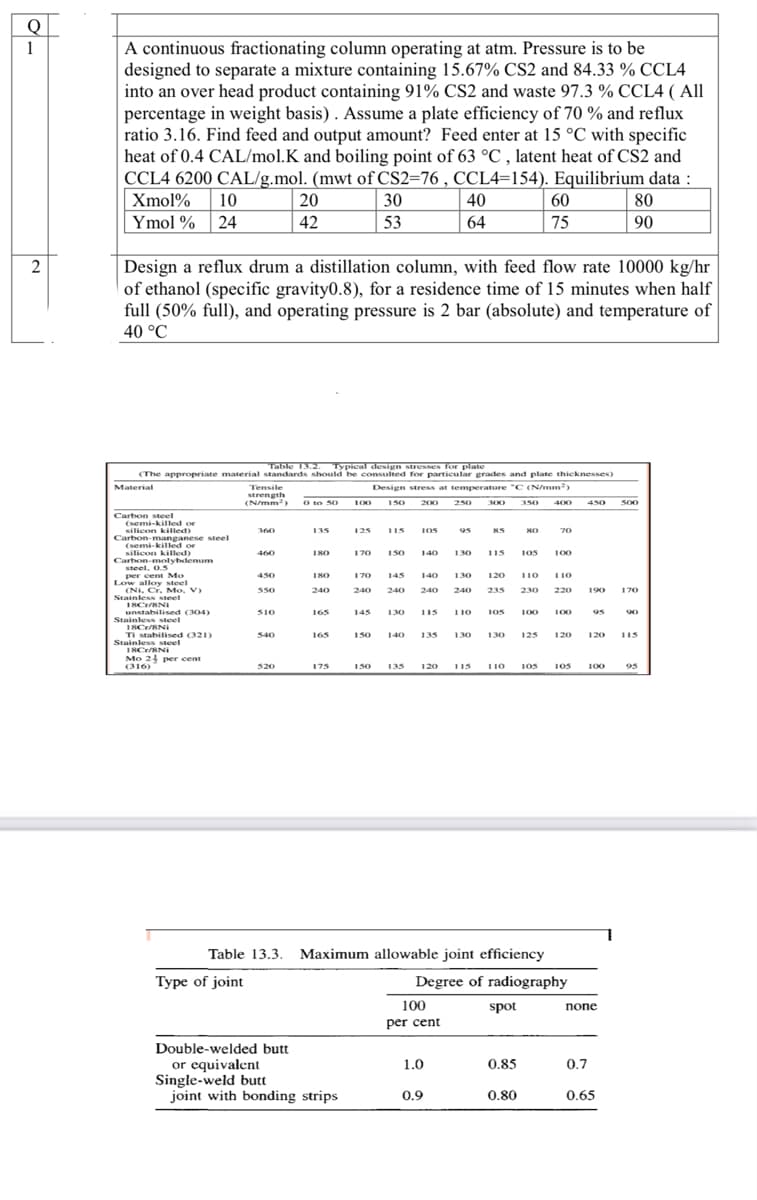Design a reflux drum a distillation column, with feed flow rate 10000 kg/hr of ethanol (specific gravity0.8), for a residence time of 15 minutes when half full (50% full), and operating pressure is 2 bar (absolute) and temperature of 40 °C
Design a reflux drum a distillation column, with feed flow rate 10000 kg/hr of ethanol (specific gravity0.8), for a residence time of 15 minutes when half full (50% full), and operating pressure is 2 bar (absolute) and temperature of 40 °C
Introduction to Chemical Engineering Thermodynamics
8th Edition
ISBN:9781259696527
Author:J.M. Smith Termodinamica en ingenieria quimica, Hendrick C Van Ness, Michael Abbott, Mark Swihart
Publisher:J.M. Smith Termodinamica en ingenieria quimica, Hendrick C Van Ness, Michael Abbott, Mark Swihart
Chapter1: Introduction
Section: Chapter Questions
Problem 1.1P
Related questions
Question
I need answer Q2

Transcribed Image Text:Q
1
2
A continuous fractionating column operating at atm. Pressure is to be
designed to separate a mixture containing 15.67% CS2 and 84.33 % CCL4
into an over head product containing 91% CS2 and waste 97.3 % CCL4 (All
percentage in weight basis). Assume a plate efficiency of 70 % and reflux
ratio 3.16. Find feed and output amount? Feed enter at 15 °C with specific
heat of 0.4 CAL/mol.K and boiling point of 63 °C, latent heat of CS2 and
CCL4 6200 CAL/g.mol. (mwt of CS2-76, CCL4=154). Equilibrium data:
Xmol%
10
20
30
40
60
80
Ymol % 24
42
53
64
75
90
Design a reflux drum a distillation column, with feed flow rate 10000 kg/hr
of ethanol (specific gravity0.8), for a residence time of 15 minutes when half
full (50% full), and operating pressure is 2 bar (absolute) and temperature of
40 °C
Table 13.2. Typical design stresses for plate
(The appropriate material standards should be consulted for particular grades and plate thicknesses)
Material
Tensile
Design stress at temperature "C (N/mm²)
strength
100
(N/mm²) 0 to 50
150 200
250
300
350
400 450 500
Carbon steel
(semi-killed or
silicon killed)
360
135
125
115
105
95
85
80
70
Carbon-manganese steel
(semi-killed or
silicon killed)
Carbon-molybdenum
180
170
150
140 130 115 105
100
steel, 0.5
per cent Mo
450
180
170
145
110
Low alloy steel
140 130 120 110
240 240 235
550
240
240
240
230 220 190 170
(Ni, Cr, Mo, V)
Stainless steel
18Cr/BNI
510
165
145
115
130
90
110
105
100
100
95
unstabilised (304)
Stainless steel
18Cr/BNi
540
165
150 140 135 130 130
125
120
120 115
Ti stabilised (321)
Stainless steel
18Cr/Ni
Mo 24 per cent
(316)
520
175
150 135 120 115 110 105 105 100
95
Table 13.3. Maximum allowable joint efficiency
Degree of radiography
100
spot
per cent
1.0
0.85
0.9
0.80
Type of joint
Double-welded butt
or equivalent
Single-weld butt
joint with bonding strips
none
0.7
0.65
Expert Solution
This question has been solved!
Explore an expertly crafted, step-by-step solution for a thorough understanding of key concepts.
Step by step
Solved in 2 steps with 2 images

Recommended textbooks for you

Introduction to Chemical Engineering Thermodynami…
Chemical Engineering
ISBN:
9781259696527
Author:
J.M. Smith Termodinamica en ingenieria quimica, Hendrick C Van Ness, Michael Abbott, Mark Swihart
Publisher:
McGraw-Hill Education

Elementary Principles of Chemical Processes, Bind…
Chemical Engineering
ISBN:
9781118431221
Author:
Richard M. Felder, Ronald W. Rousseau, Lisa G. Bullard
Publisher:
WILEY

Elements of Chemical Reaction Engineering (5th Ed…
Chemical Engineering
ISBN:
9780133887518
Author:
H. Scott Fogler
Publisher:
Prentice Hall

Introduction to Chemical Engineering Thermodynami…
Chemical Engineering
ISBN:
9781259696527
Author:
J.M. Smith Termodinamica en ingenieria quimica, Hendrick C Van Ness, Michael Abbott, Mark Swihart
Publisher:
McGraw-Hill Education

Elementary Principles of Chemical Processes, Bind…
Chemical Engineering
ISBN:
9781118431221
Author:
Richard M. Felder, Ronald W. Rousseau, Lisa G. Bullard
Publisher:
WILEY

Elements of Chemical Reaction Engineering (5th Ed…
Chemical Engineering
ISBN:
9780133887518
Author:
H. Scott Fogler
Publisher:
Prentice Hall


Industrial Plastics: Theory and Applications
Chemical Engineering
ISBN:
9781285061238
Author:
Lokensgard, Erik
Publisher:
Delmar Cengage Learning

Unit Operations of Chemical Engineering
Chemical Engineering
ISBN:
9780072848236
Author:
Warren McCabe, Julian C. Smith, Peter Harriott
Publisher:
McGraw-Hill Companies, The